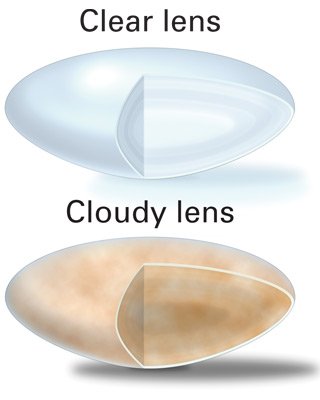Everything You Need To Know About Cataracts
One of the most common and talked about ocular disease is cataracts. Affecting millions of people each year, cataracts are the leading cause of blindness across the world. June is Cataracts Awareness Month, and as a result we’re going to deep dive into what cataracts are, how they form, how they’re treated, and how they can be prevented.
Image from: What Are Cataracts?, American Academy of Ophthalmology
Cataracts are essentially cloudiness in our natural lens. Our friends over at All About Vision explain it best: while lenses are supposed to be clear, cataracts cloud lenses and appears as a haze or fog as we look around us. This distortion of the lens doesn’t seem so bad at first, but can progressively get worse and cause blindness unless treated.
Cataracts can form from a number of possible causes. The most common occurs from natural aging, when normal proteins in the lens start to break down. These broken down proteins are what begin to appear as cloudiness. Despite this, vision problems severe enough to affect vision may not occur until much later. Eye injury and damage from UV rays are other leading causes of cataracts, while diabetes, smoking, prolonged use of corticosteroid medications (think arthritis and asthma medications), and genetics can also cause cataracts to form.
But! While there is no concrete proof that we can fully prevent cataracts, studies have identified things that can help prevent cataracts from forming, like certain nutrients and UV-protective glasses and sunglasses. Vitamin E, lutein, and zeaxanthin (found most commonly in leafy greens, nuts, and fruits) have been associated with significantly decreased risk of cataracts. Other studies suggest antioxidants like vitamin C and omega-3 fatty acids (citrus fruits, eggs, and fish) can also reduce cataract risks. And to prevent cataracts from UV damage: wearing sunglasses or eyeglasses that fully block the Sun’s UV rays.
In minor and early stages, cataracts can be treated simply by using glasses with stronger prescriptions than previous. However, as cataracts progress, surgery is usually the most straightforward approach to treating cataracts. During cataract removal surgery, the surgeon will remove the clouded lens and replace it with an artificial lens known as a plastic intraocular lens (IOL). These replacement lens are constantly being refined and researched to be better than previous generations. Two types that stand out from the rest are presbyopia-correcting IOLs that can improve sight at all distances instead of one, while another type of IOL is being studied on its ability to block UV and HEV rays, preventing future retinal damage.
Cataracts are a global condition, affecting millions around the world each year. June is dedicated to cataract awareness because, though it’s a treatable disease in many first world countries, it usually goes untreated around the world in developing countries. Organizations like See International and Himalayan Cataract Project work hard year round to treat cataracts and teach doctors and surgeons how to remove and treat cataracts. By bringing attention to cataracts, we can work together to prevent them and give the world 20⁄20 vision.


